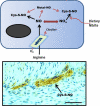S-nitrosothiol signals in the enteric nervous system: lessons learnt from big brother
- PMID: 21441985
- PMCID: PMC3058138
- DOI: 10.3389/fnins.2011.00031
S-nitrosothiol signals in the enteric nervous system: lessons learnt from big brother
Abstract
Nitric oxide (NO) is a functionally important neurotransmitter signaling molecule generated by mammalian and bacterial nitric oxide synthases (NOS), and by chemical conversion of dietary nitrite in the gastrointestinal (GI) tract. Neuronal NOS (nNOS) is the most abundant isoenzyme in the enteric nervous system, and targeted deletion in transgenic mice has clearly demonstrated its importance in normal gut function. Enteric neuropathy is also often associated with abnormal NO production, for example in achalasia and diabetic gastroparesis. Not surprisingly therefore, aberrant nNOS activity is widely implicated in enteric disease, and represents a potential molecular target for therapeutic intervention. One physiological signaling mechanism of NO bioactivity is through chemical reaction with the heme center of guanylyl cyclase, resulting in the conversion of cGMP from GTP. This second messenger nucleotide signal activates cGMP-dependent protein kinases, phosphodiesterases, and ion channels, and is implicated in the neuronal control of GI function. However, few studies in the GI tract have fully related NO bioactivity with specific molecular targets of NO-derived signals. In the central nervous system (CNS), it is now increasingly appreciated that NO bioactivity is often actively transduced via S-nitrosothiol (SNO) signals rather than via activation of guanylyl cyclase. Moreover, aberrant S-nitrosylation of specific molecular targets is implicated in CNS pathology. S-nitrosylation refers to the post-translational modification of a protein cysteine thiol by NO, forming an endogenous SNO. Because cysteine residues are often key regulators of protein function, S-nitrosylation represents a physiologically important signaling mechanism analogous to other post-translational modifications, such as O-phosphorylation. This article provides an overview of how neurotransmitter NO is produced by nNOS as this represents the most prominent and well defined source of SNO production in the enteric nervous system. Further, it provides a perspective of how S-nitrosylation signals derived from multiple diverse sources may potentially transduce NO bioactivity in the GI tract. Possible lessons that might be learnt from the CNS, such as SNO mediated auto-inhibition of nNOS activity and modulation of neuronal cell death, are also explored as these may have pathophysiological relevance in enteric neuropathy. Thus, S-nitrosylation may mediate previously underappreciated NO-derived signals in the enteric nervous system that regulate homeostatic gut functions and disease susceptibility.
Keywords: S-nitrosoglutathione; S-nitrosothiol; enteric glia and neurons; enteric neuropathy; nNOS; nitric oxide.
Figures


Similar articles
-
Basal and stimulated protein S-nitrosylation in multiple cell types and tissues.J Biol Chem. 2002 Mar 22;277(12):9637-40. doi: 10.1074/jbc.C100746200. Epub 2002 Jan 16. J Biol Chem. 2002. PMID: 11796706
-
Coupling between neuronal nitric oxide synthase and glutamate receptor 6-mediated c-Jun N-terminal kinase signaling pathway via S-nitrosylation contributes to ischemia neuronal death.Neuroscience. 2008 Sep 9;155(4):1120-32. doi: 10.1016/j.neuroscience.2008.03.061. Epub 2008 Apr 4. Neuroscience. 2008. PMID: 18676085
-
Protein S-Nitrosylation: Determinants of Specificity and Enzymatic Regulation of S-Nitrosothiol-Based Signaling.Antioxid Redox Signal. 2019 Apr 1;30(10):1331-1351. doi: 10.1089/ars.2017.7403. Epub 2018 Jan 10. Antioxid Redox Signal. 2019. PMID: 29130312 Free PMC article. Review.
-
Nitrosothiol formation and S-nitrosation signaling through nitric oxide synthases.Nitric Oxide. 2017 Feb 28;63:52-60. doi: 10.1016/j.niox.2016.10.001. Epub 2016 Oct 5. Nitric Oxide. 2017. PMID: 27720836 Review.
-
Importance of NO and its related compounds in enteric nervous system regulation of gut homeostasis and disease susceptibility.Curr Opin Pharmacol. 2014 Dec;19:54-60. doi: 10.1016/j.coph.2014.07.009. Epub 2014 Aug 7. Curr Opin Pharmacol. 2014. PMID: 25108170 Free PMC article. Review.
Cited by
-
Diabetic gastrointestinal motility disorders and the role of enteric nervous system: current status and future directions.Neurogastroenterol Motil. 2014 May;26(5):611-24. doi: 10.1111/nmo.12330. Epub 2014 Mar 24. Neurogastroenterol Motil. 2014. PMID: 24661628 Free PMC article. Review.
-
Role of enteric neurotransmission in host defense and protection of the gastrointestinal tract.Auton Neurosci. 2014 Apr;181:94-106. doi: 10.1016/j.autneu.2013.12.006. Epub 2013 Dec 22. Auton Neurosci. 2014. PMID: 24412639 Free PMC article. Review.
-
Gender bias in gastroparesis: is nitric oxide the answer?Dig Dis Sci. 2011 Sep;56(9):2520-7. doi: 10.1007/s10620-011-1735-6. Epub 2011 May 11. Dig Dis Sci. 2011. PMID: 21559738 Free PMC article. Review.
-
Enteric glial cells and their role in the intestinal epithelial barrier.World J Gastroenterol. 2014 Aug 28;20(32):11273-80. doi: 10.3748/wjg.v20.i32.11273. World J Gastroenterol. 2014. PMID: 25170211 Free PMC article. Review.
-
Role of oxidative stress in oxaliplatin-induced enteric neuropathy and colonic dysmotility in mice.Br J Pharmacol. 2016 Dec;173(24):3502-3521. doi: 10.1111/bph.13646. Epub 2016 Nov 16. Br J Pharmacol. 2016. PMID: 27714760 Free PMC article.
References
-
- Andrew P. J., Mayer B. (1999). Enzymatic function of nitric oxide synthases. Cardiovasc. Res. 43, 521–531 - PubMed
-
- Benhar M., Forrester M. T., Stamler J. S. (2009). Protein denitrosylation: enzymatic mechanisms and cellular functions. Nat. Rev. Mol. Cell Biol. 10, 721–732 - PubMed
-
- Boissel J. P., Zelenka M., Gödtel-Armbrust U., Feuerstein T. J., Förstermann U. (2003). Transcription of different exons 1 of the human neuronal nitric oxide synthase gene is dynamically regulated in a cell- and stimulus-specific manner. Biol. Chem. 384, 351–362 - PubMed
Grants and funding
LinkOut - more resources
Full Text Sources

